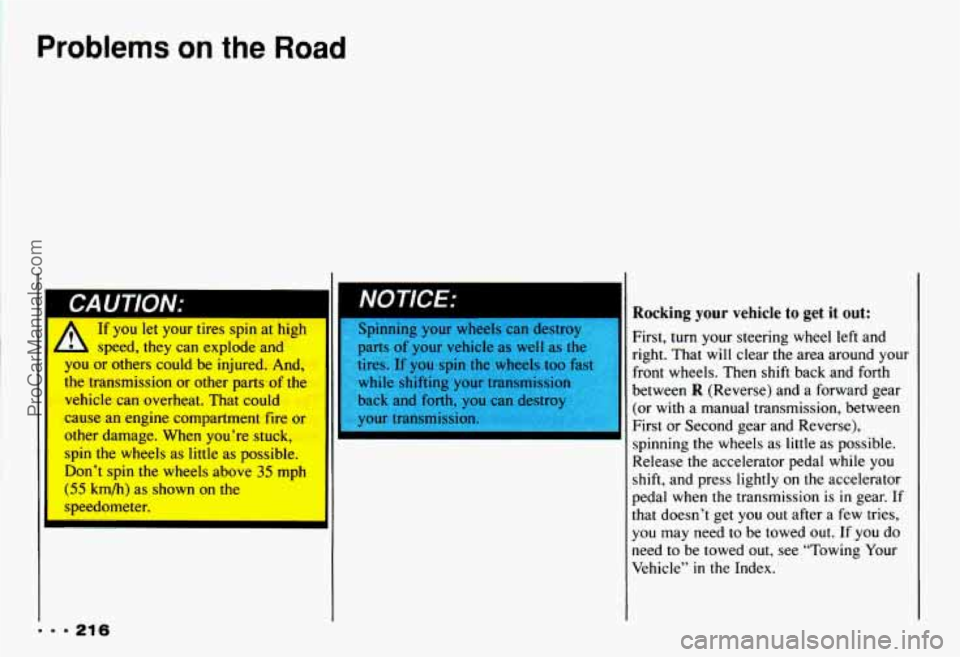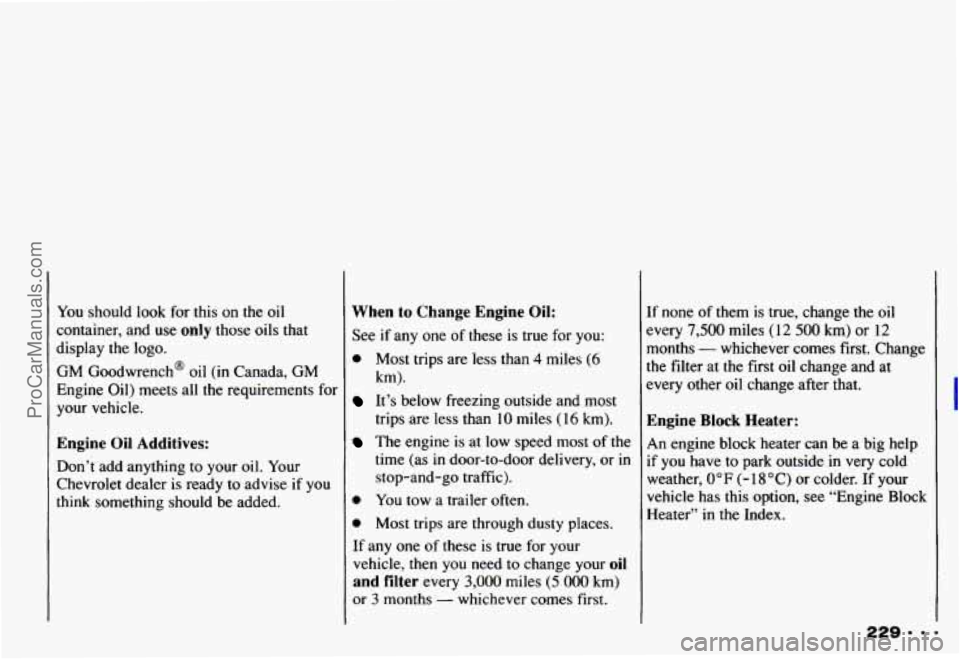Page 197 of 358
I
c
Do not tow with sling-type
eauipment or rear bumDer valance
equipment. Additional ramping may
be required for car carrier equipment.
Use safety chains and wheel straps. Attach
a separate
safety chain around
outboard end
of the rear axle.
NOTICE: I
could damage a vehicle. Damage can
occur from both vehicle-to-ground
or vehicle-to-wheel-lift-equipment
To help avoid damage, install
g dolly and raise vehicle until
er clearance is obtained between
the ground and/or wheel-lift equipment.
Engine Overheating
You will find a coolant temperature gage
on your Chevrolet's instrument panel.
You may also find a low coolant warning
light on your Chevrolet instrument panel.
193 9
ProCarManuals.com
Page 198 of 358

Problems on the Road
If Steam Is Coming from Your Engine:
W1Ldr-W II LUU I ILJN.'
Steam from an overheated engine can bum you badly, even if you just open
k the hood. Stay away from the engine if you see or hear steam coming from
x. Just turn it off and get everyone away from the vehicle until it cools down.
Wait
until there is no sign of steam or coolant before opening the hood.
If you keep driving when your engine is overheated, the liquids in it can catch
fire. You or others could be badly burned. Stop your engine if it overheats, and
get out of the vehicle until the engine is cool,
... 194
11 your engine catches fire because
I you keep driving with no coolant,
I1
E
I1
h
tC
a
0
a
a
your vehicle can be badly damaged
The
costly repairs would not be
covered by your warranty.
F No Steam Is Coming from Your
hgine:
'you get the overheat warning but see or
ear
no steam, the problem may not be
)o serious. Sometimes the engine can get
little too
hot when you:
Climb a long hill on a hot day.
Stop after high speed driving.
1 Idle for long periods in traffic.
1 Tow a trailer.
ProCarManuals.com
Page 208 of 358
Problems on the Road
I lh
1
F. $. '
9. Shut the engine off and replace the
pressure cap. Be sure the arrows
on
the cap line up like this.
Y CI.
10. Then fill the coolant recovery tank
For a complete drain. flush and refill, see
your Chevrolet dealer or a Chevrolet
Carnaro Service
Manual. To purchase
a service manual, see "Service
Publications"
in the Index.
to the proper level.
If a Tire Goes Flat
It's unusual for
a tire to "blow out" while
you're driving, especially
if you maintain
your tires properly.
If air goes out of a
tire, it's much more likely
to leak out
slowly.
But if you should ever have a
"blowout," here are a few tips about what
to expect and what to do:
If a front tire fails, the flat tire will create
a drag that pulls the vehicle toward that
side. Take your foot off the accelerator
pedal and grip the steering wheel firmly.
Steer
to maintain lane position, then
gently brake to a stop well out of
the
traffic lane.
ProCarManuals.com
Page 215 of 358
I
A Rust or dirt on the wheel, or on
the parts to which it is fastened,
can make the wheel nuts become
loose after a time. The wheel could
come off and cause an accident.
When you change a wheel, remove
any rust or dirt from the places
where the wheel attaches to the
vehicle. In an emergency, you can
use a cloth or a paper towel to do
this; but be sure to use a scraper or
wire brush later, if you need to, to
get all the rust or dirt off.
I
I
1
1
!
I
I
Remove any rust or dirt from the wheel
3olts, mounting surfaces or spare wheel.
Place the spare on the wheel mounting
surfxe.
A
Never use oil or grease on
studs or nuts. If you do, the
nuts might come loose. Your wheel
could
fall off, causing a serious
accident.
i
Replace the wheel nuts with the roundec-1
end of the nuts toward the wheel. Tighten
each nut by hand until the wheel is held
against the hub.
211
ProCarManuals.com
Page 220 of 358

Problems on the Road
If you let your tires spin at high
speed, they can explode and
you or others could be injured. And,
the transmission or other partsof the
vehicle can overheat. That could
II I
I
cause an engine compartment fire or
other damage. When you’re stuck,
spin the wheels as little as possible.
Don’t spin the wheels above
35 mph
(55 km/h) as shown on the
speedometer.
I
Spinning your wheels can destroy
parts of your vehicle as well as the
.ires. If you spin the wheels too fast
Nhile shifting your transmission
aack and
forth, you can destro!,
your transmission.
Rocking your vehicle to get it out:
First, turn your steering wheel left and
right. That will clear the area around your
front wheels. Then shift back and forth
between
R (Reverse) and a forward gear
(or with a manual transmission, between
First or Second gear and Reverse),
spinning the wheels as little as possible.
Release the accelerator pedal while you
shift, and press lightly on
the accelerator
pedal when the transmission is
in gear. If
that doesn’t get you out after a few tries,
you may need to be towed out. If you do
need to be towed out, see “Towing Your
Vehicle”
in the Index.
... 21 6
ProCarManuals.com
Page 230 of 358
Service & Appearance Care
. = 226
Engine Oil 3.4L L32 (Code S)
It's a good idea to check your engine oil
every time
you get fuel. In order to get an
accurate reading, the oil must be warm
and the vehicle must be on level ground,
5.7L LTl (Code P)
Turn off the engine and give the oil a few
minutes to drain back into the oil
pan. If
you don't, the oil dipstick might not show
the actual level.
To Check Engine Oil
(3.4L L32 (Code S) Engine)
Pull out the dipstick and clean it with a
paper towel or cloth, then push it back in
all the way. Remove it again, keeping the
tip lower.
ProCarManuals.com
Page 233 of 358

You should look for this on the oil
container, and use
only those oils that
display the logo.
GM Goodwrench@
oil (in Canada, GM
Engine Oil) meets all
the requirements for
your vehicle.
Engine Oil Additives:
Don’t add anything to your oil. Your
Chevrolet dealer is ready
to advise if you
think something should be added.
When to Change Engine Oil:
See if any one of these is true for you:
0 Most trips are less than 4 miles (6
km).
It’s below freezing outside and most
trips are less than
10 miles (16 km).
The engine is at low speed most of the
time (as
in door-to-door delivery, or in
stop-and-go traffic).
0 You tow a trailer often.
0 Most trips are through dusty places.
If any one of these is true for your
vehicle, then you need to change your
oil
and filter every 3,000 miles (5 000 km)
or 3 months - whichever comes first. If none
of them is true, change the oil
every
7,500 miles (12 500 km) or 12
months - whichever comes first. Change
the filter at the first oil change and at
every other
oil change after that.
Engine Block Heater:
An engine block heater can be a big help
if you have to park outside in very cold
weather,
0 OF (- 1 8 O C) or colder. If your
vehicle has this option, see “Engine Block
Heater’’
in the Index.
ProCarManuals.com
Page 238 of 358
Service & Appearance Care
if outside temperatures are 50°F (10°C)
or more. If it's colder than 50°F (lO°C),
you may have to idle the engine longer.
A hot check must follow when fluid is
added during a cold check.
To check the fluid hot or cold:
0 Park your vehicle on a level place.
Place the shift lever in P (Park) with
0 With your foot on the brake pedal,
the parking brake
applied.
move
the shift lever through each gear
range, pausing for about
three seconds
in each range. Then, position the shift
lever in
P (Park).
minutes or more.
0 Let the engine run at idle for three
234
A
3.4L L32 (Code S)
Then, without shutting off the engine,
follow these steps:
1. Pull out the dipstick and wipe it with a
clean rag or paper towel.
3
2
5.7L LTl (Code P)
!. Push it back in all the way, wait three
seconds and then pull it back
out
again.
ProCarManuals.com